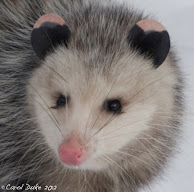Sometimes life simply, softly, silently spills into itself. Expanding into crowdedness . . . even fluff can push its way out . . . creating its own freedom from a small casing. Where an earlier opening of the seams of Asclepias (A. syriaca) . . . Common Milkweed, would have revealed a sticky, milky substance . . . today the silky downy fibers float seeds out into the breeze.
Like the Monarch butterflies (whose existence depends on this host plant) before them, the fresh seeds now take their first flight.
There is a perfect pear or teardrop shape in each seed. To see the flowers visit an earlier Wildflower Wednesday post. The seeds take flight with their silk parachutes along with autumn leaves whisked about by wind or rain to their intended destiny. Of course the intention is meant to be purely accidental . . . dependent on the whim of the wind and other elemental happenstances.
Just as coincidental dotted about the garden there are tiny Azure Asters . . . that may be their name. Bombus impatiens . . . the bumblebees . . . have a different name or way of recognizing these valued late blooms.
There are still some New England Asters blooming in the south field. . . but nearly gone are these great Autumn feeders.
A Heart-leaved Aster (Symphyotrichum cordifolium) is greatly beloved by many insects this time of year.
The Bombus Impatiens are often seen in our eastern gardens and are also raised for greenhouse pollination in California and Mexico. Bumblebees are escaping the greenhouses and are a threat to the wild native bumblebees in those regions. Sound familiar . . . when we industrialize living plants or animals and send them all over the world we often create an imbalance.
The non native bees are spreading viruses to the native bees in California. . . the industrialize bees seem to have more pathogens than the natives. Sounds familiar too, right? The bees are not to blame and you can learn more about this important issue at a great site xerces .
Bombus impatiens have large colonies, though not quite as big as Honeybees (a post where I compare Wild Honeybees to bloggers.) Hundreds of Asclepias (A. syriaca) seeds form neatly in their molded casing . . . what consciousness is there here? Not active as a bumblebee or honeybee colony . . . though each seed grows its own tassel of silken hair that will be caught in an hiccup of air . . . it will sail away . . . up high . . . sometimes above the Rock Maple tree tops, where the wild Honeybees reside. Life in wait . . . intelligence or simply mechanical? I believe plant intelligence within each seed that sleeps . . . then when awakening . . . sprouts a long milky white, fleshy taproot . . . piercing and entering the earth . . . anchoring a noble plant of unique qualities and beauty. It will breathe, exhale and perhaps sigh . . . though never wondering why . . . throughout its wild days. I do value wonderment and the process of wondering . . . we can learn through our observations . . . by seeing and listening to the life within our gardens . . . the birds and bees and trees and plants have much to teach us. They touch our lives and make us truly whole. Wildflower Wednesday founded by our gracious hostess Gail over at Clay and Limestone gives us a day to think more wildly . . . be sure to click on over to her garden to see other gardeners wild -thoughts, life and flowers.










































































































































